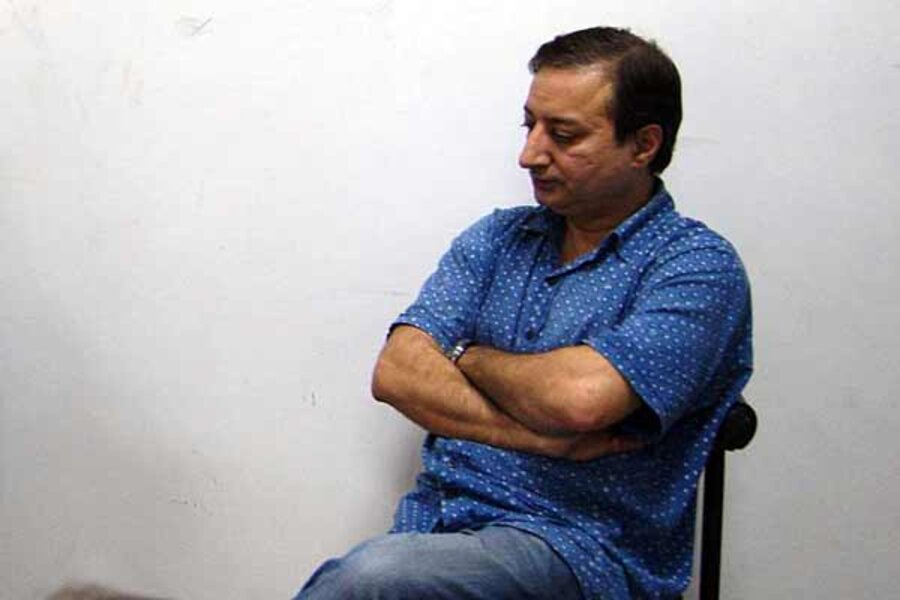Another courageous casualty in Pakistan, journalism's most dangerous country
Loading...
| Boston
Two weeks ago I was in an office in Karachi, Pakistan, with a room full of journalists, including Murtaza Razvi, an editor at Dawn newspaper, discussing challenges facing the country’s vibrant media, including risks to covering Pakistan. Yesterday I was e-mailed that he had been murdered.
Before I left for Pakistan a few weeks ago on a journalist exchange program sponsored by the East-West Center, I asked colleagues who reported in the country, both Pakistani and American, about their greatest challenge.
Americans complained of the government's game of “smoke and mirrors,” a disinformation campaign that puts most other government propaganda efforts to shame. The challenge for Pakistani journalists, on the other hand, was decidedly more severe. “We have a completely free media in Pakistan, but no protection,” said one journalist based in Islamabad.
How severe? The country leads the world in journalist murders, the latest just yesterday.
Seven of the other eight Pakistani journalists at a meeting with my group proceeded to share stories of threats. It was common, they said, to receive a threat by a phone call from the Taliban for not getting enough quotes from them, from political parties for including the Taliban in a story or not being represented the way they saw fit, and even from Pakistan’s version of the CIA, the ISI.
But this wasn’t something that had them lining up to find a new job. It was just how things work. Most of the time the person on the other end of the line is bluffing, they said. They had gotten used to the fact that Pakistan was the deadliest country for journalists in 2010 and 2011, according to the Committee to Protect Journalists. And killings there have been met with near-perfect impunity throughout the years. For some perspective, consider that there have been 19 unsolved murders of journalists since 2002. (see CPJ’s video)
When you put it that way, having to peer through smoke and mirrors to get to the heart of a story doesn't look so bad.
I visited the Ministry of Information and Broadcasting while I was in Pakistan. The ministry has jurisdiction over the rules and regulations relating to information, broadcasting, and the press. Like many Pakistanis we spoke to on this trip, the minister talked at length about how wonderful it was to have an active, independent, vibrant media that had absolutely no restrictions and how that was contributing to democracy in Pakistan.
However, when we raised the question of safety and reported threats against journalist, Minister of Information Firdous Ashiq Awan (since replaced), without asking for details or pausing to smooth this over, said: “Those are complete fabrications. It never happened. It’s not happening.”
We brought up the famous case of Syad Saleem Shazad, a prominent journalist who went missing after exposing Al Qaeda infiltration of the military. He had been “warned” several times by the ISI for covering sensitive topics, according to his family. He was later found dead. The ISI, was implicated, though it denied involvement.
The minister dismissed the scenario of Shazad's murder as unproven. She did clarify that, "we condemn that sort of action." But she stuck with her statement that there were no threats or real dangers for journalists who were not "over smart." A former local journalist who now works in the ministry agreed with her.
At this point, Issam Ahmed, the Monitor’s Islamabad correspondent, who had been invited to the round table by the minister, shared a story about a time he had been reporting on a sensitive topic in northern Pakistan, when he was summoned into a car by agents to go meet with the ISI bureau chief. The car sped off at breakneck speed to the headquarters, where the chief warned him to “not report critically.” So, Issam, said, it wasn't a death threat, but intimidation happens.
The conversation at the ministry quickly shifted – but it highlighted in that moment, both the smoke and mirrors that western journalists had discussed, as well as the physical risks for local journalists.
My trip was meant to promote understanding of Pakistan – and it did. There are real reasons for optimism about Pakistan’s future, especially when it comes to civil society. I shared some of those reasons for optimism with my newsroom yesterday, and at the end of my presentation was asked if I would go back if I had the chance. I answered that I would go in a heartbeat. I felt completely safe through my entire trip and another part of what makes me optimistic has to do with the number of incredibly smart, inventive 20- and 30-somethings I came across while I was there. Many of them could live anywhere, but choose to live in Pakistan and dedicate their lives to shaping that country.
Moments after my talk to the newsroom I was back at my desk where I received a message from an editor at Dawn, the leading English daily newspaper in Pakistan.
“Murtaza Razvi a member of Dawn editorial team whom u met at the meeting here has been murdered,” she wrote me.
A well-known columnist, Mr. Razvi came across as a sharp, thoughtful man when we met two weeks ago at Dawn's offices. Married and in his 40s with three daughters, he was known by his colleagues to live a liberal lifestyle.
He was found in an apartment in Karachi, evidently tortured and strangled. The reasons for his death aren't clear at this point. He came from a Shiite family but was not religious. Friends and acquaintances point out that his liberal views and lifestyle may have ruffled feathers. And his last article was about how India-Pakistan peace would be good for neutralizing hawks inside and outside the military. You could call that a rather sensitive topic.
Before I left for Pakistan a few weeks ago I had an inclination of the government's game of “smoke and mirrors,” and the physical dangers that reporters faced there. While I was there, I was given this very safe look at Pakistan, its high security, great food, and conversation with very smart entrepreneurs and journalists fighting to raise important issues. One week after my return a journalist whom I met and talked with is now dead. And I wonder: What is media freedom without protection?
Pakistani reporters will continue to report despite dangers. They'll watch how they mention the Taliban, the political parties, and ISI. Sometimes they'll be bullied into softening the edges of their reports. But mostly they'll press on. The hope is that their work, in life and in death, bring home the scale of complexity and challenges that Pakistan has yet to overcome.
Pete Hamill sums it up in his book “News is a Verb."
“They knew that only part of the truth could be discovered in the safe offices in Washington, D.C.; they had to witness the dark truths by getting down in the mud with the grunts. They died because they believed in the fundamental social need for what they did with a pen, a notebook, a typewriter, or a camera. They didn’t die to increase profits for the stockholders. They didn’t die to obtain an invitation to some White House dinner for a social-climbing publisher. They died for us. … They died to bring us the truth.”
He was writing for the Vietnam-era journalist, but it certainly applies to the passion and commitment of journalists in Pakistan who live, and die, for their efforts to uncover truth today.
Asia editor Jenna Fisher and five other US journalists recently traveled to Pakistan as part of an exchange program coordinated by the East-West Center, which concurrently sent nine Pakistani journalists to the United States. For more information, visit: www.eastwestcenter.org.






